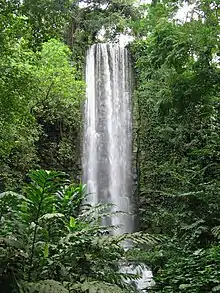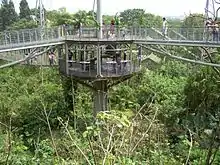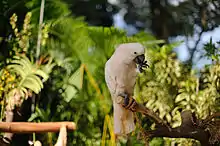Jurong Bird Park
Jurong Bird Park is an aviary and tourist attraction in Jurong, Singapore. The bird park, managed by Wildlife Reserves Singapore, covers an area of 0.2 square kilometres (49 acres) on the western slope of Jurong Hill, the highest point in the Jurong region. It is one of the park managed by Wildlife Reserves Singapore with Singapore Zoo, Night Safari and River Safari.
 | |
 | |
| Date opened | 3 January 1971 |
|---|---|
| Location | Jurong, Singapore 2 Jurong Hill, Singapore 628925 (1971–2022) Mandai, Singapore 80 Mandai Lake Road, Singapore 729826 (2022 onwards) |
| Coordinates | 1°19′05″N 103°42′26″E |
| Land area | 20.2 ha (50 acres) |
| No. of animals | 12,000[1] |
| No. of species | 500[1] |
| Annual visitors | 768,933 (FY 2019/20)[2] |
| Owner | Wildlife Reserves Singapore |
| Website | www |
Wildlife Reserves Singapore reported on 1 June 2016 that in 2020, Jurong Bird Park will be relocated to Mandai Lake Road with a new name for the Bird Park.[3][4] However, due to impact from the COVID-19 pandemic, the move was pushed back to 2022.
History

The idea of a permanent aviary was first conceived by the late Dr Goh Keng Swee, then Minister for Finance, in 1968. During a World Bank meeting in Rio de Janeiro, Dr Goh visited its zoological garden and was impressed with its free-flight aviary. He set out to ensure that Singaporeans would have a place where they could escape from urban life and relax with nature.[5][6]
Work on the aviary started in January 1969.[7] A 35-acre site on the western slope of Bukit Peropok in Jurong was chosen for the project. The bird park was expected to be completed by the end of 1969.[8]
On 3 January 1971, Jurong Bird Park, built at a cost of S$3.5 million, was opened to the public.[9]
Jurong Bird Park is now a world-famous bird zoo where there are specimens of magnificent bird life from around the world, including a large flock of flamingos. It is currently the world's largest bird park in terms of the number of birds, and second largest both in the number of bird species and land area (after Germany's Weltvogelpark Walsrode). There are 5,000 birds of 400 species in Jurong Bird Park, of which 29 are of threatened species.[1]
In 2006, Jurong Bird Park completed a S$10 million makeover. As a result of the upgrade, the park got a new entrance plaza, a park-owned and managed Bongo Burgers restaurant, an ice cream parlour, a gift shop and a bird hospital.[10]
Exhibits
Waterfall Aviary

The Waterfall Aviary, which focuses mostly on birds from Africa, has bird enclosures that extend to a towering height of 35 metres. At 20,000-square-metre (4.9-acre) walk-in aviary it is the second largest in the world. The area houses the 30-metre (98 ft) tall Jurong Falls, one of the world's tallest man-made, indoor waterfalls. Water plunges over the top of a towering cliff at a rate of 140 litres (37 US gal) per second. The water is recirculated through a meandering stream that cascades down over a series of levels, creating an ideal environment for water birds, fishes, plants and other lifeforms at the aviary. A suspension bridge in the zone allows visitors to get a panoramic view of the surrounding landscape and a hiking trail lets the visitors catch sight of some of the more reticent birds in action. It houses some 1,500 free-flying birds from 80 African species and 10,000 plants with 125 species of trees, bamboo, palms and ground-cover vegetation, including various species of birds around the world including Helmeted guineafowl, Victoria crowned pigeon, Chinese hwamei, Roseate spoonbill, Javan green magpie and many more.
Dinosaur Descendants
The Dinosaur Descendants section houses some of the largest extant birds, including various species of crane, and large flightless birds such as ostriches, emus and cassowaries.
Wings of Asia
Visitors can see the largest collection of Southeast Asian birds, which has over 200 species. There are large, central walk-in aviaries and peripheral aviaries housing the more delicate and territorial birds. A thunderstorm is simulated at noon each day, followed by a cool, light drizzle. Territorial species are kept in large cages, while species that can coexist with each other (fruit doves and pigeons being two examples) are left to roam freely in the aviary. There are various species of parrots from Asia including the Long-tailed parakeet and pheasants such as the Great argus pheasant and the Temminck's tragopan, doves and pigeons including Jambu fruit doves, Common emerald doves and Pied imperial pigeons and highly endangered species such as the critically endangered Bali mynah and Rufous-fronted laughingthrush.
Lory Loft

About nine storeys high and covering 3,000 square metres (32,000 sq ft), the Lory Loft is the world's largest walk-in flight aviary for lories and lorikeets, with over 1,000 free-flying lories. Other species housed here include the megapodes, currawongs, eclectus parrots, king parrots, cockatoos, and various Australasian parakeets. The ambience is similar to that of a rainforest valley in tropical Northern Australia. Visitors can offer the lories a special nectar mix.
Parrot Paradise
This small zone houses some of the park's parrot species, mostly macaws such as Scarlet macaws, Hyacinth macaws and Spix's macaws; cockatoos like Salmon-crested cockatoos, Red-tailed black cockatoos and Galahs; and parakeets including Burrowing parakeets, Sun conures and Golden conures and dozens of rare parrot species.
Penguin Coast
_(6025142541).jpg.webp)
Houses five species of penguins within 1,600 square metres (17,000 sq ft). Featuring a 21-metre (69 ft) tall Portuguese galleon façade and designed to resemble a ship, the interior of Penguin Coast is constructed with timber beams and wooden flooring. Penguin Coast is home to the Humboldt, rockhopper, macaroni and king penguins, which live in an indoor, climate-controlled den with access to an outdoor enclosure showcasing an entire colony of endangered African penguins.
Pelican Cove
Visitors catch a glimpse of all eight species of pelicans: The endangered Dalmatian pelicans, Great white pelicans, Australian pelicans, Spot-billed pelicans, Brown pelicans, Pink-backed pelicans, Peruvian pelicans and American white pelicans. Wild herons and storks, along with the neighbouring bin chickens and greater flamingoes, sometimes join them in the exhibit. There is a board-walk where visitors can stroll and observe the birds. Visitors can also see the pelicans at the world's first underwater viewing gallery for pelicans, where the birds scoop up fish at feeding time.
Hornbills & Toucans
27 10-metre tall aviaries spread over an area of 2,000 m2 house the park's hornbill and toucan collection. Guests are often greeted upon entry by a cacophony of loud honks. There are 19 species currently on display including Rhinoceros hornbills, Southern ground hornbills, Rufous hornbills, Oriental pied hornbills and Toco toucans. Jurong Bird Park is the first to breed the black hornbill under human care. The park conducts a "Hornbill Chit-chat" session, a once-a-day interactive session where keepers bring out any one of the park's great hornbills.
Windows of Paradise
Located just beside the Lory Loft, this zone houses Twelve-wired bird-of-paradise and Lesser bird-of-paradise of which the park is the first in the world to breed the Twelve-wired bird-of-paradise. Various birds from Papua New Guinea are also housed here.
Royal Ramble
This small walk-through zone features four species of crowned pigeons, and other attractively colored species such as the Great blue turaco.
Riverine
This exhibit featured an underwater viewing panel to allow visitors to get a closer look at some of the diving birds in the exhibit. Aside from ducks and doves, this exhibit also housed southern river terrapins, Fly River turtles, iridescent sharks, saratogas and other fish species.
Breeding and Research Centre (BRC)
A small zone that showcases the handling and rearing process of the park's newly hatched birds, around 150 birds are hand-reared here each year, including many rare and endangered species like the Bali mynah and blue-throated macaw. Visitors can look at a nursery room where handling and feeding of newly hatched birds occur, as well as an incubation room to allow guests to have a look at how the park incubates their eggs.
Wetlands
Built to replicate an observation hide, this zone houses species that come from brackish habitats like mangroves and wetlands. The trees and breeding shelves in the exhibit are frequently used by the spoonbills and ibises in the exhibit. It is also home to the park's pair of shoebills.
Flamingo Pool & Flamingo Lake
The pool and lake are home to the park's flock of flamingoes, in which four species are represented, as well as free-ranging ibises, green iguanas, Cuban rock iguanas and Cape shelducks. The main pool houses the Caribbean flamingo and Chilean flamingo, along with a smaller pool for lesser flamingoes and Cape shelducks, which also inhabit Flamingo Lake. The Flamingo Lake is the largest of the three flamingo exhibits and houses the park's flock of greater flamingoes. Joining them are the lesser flamingoes from the nearby pool and Australian white ibis. The Flamingo Lodge which is open for private and special functions overlooks the Flamingo Lake and allows guests to get an even closer at the lake's inhabitants.
Shows
High Flyers Show

This bird show has the world's largest number of performing birds in a single act. Besides highlighting the antics of talented birds like the mimicking cockatoos, this show is also a window onto the natural behaviour of birds like pelicans, flamingos and hornbills.
Kings of the Skies Show
Visitors watch birds of prey such as eagles, hawks and falcons, who will fly in loops and soar above the treetops. Visitors also learn about falconry as these birds are put through their paces in a simulated hunt.
Lunch with the Parrots
Visitors enjoy a parrot show over lunch in front of the flamingo lake.
Others
Aside from birds, the park also housed some other species of animals in later years to increase the number visitors, though have stopped again to preserve the title of being a bird-only zoo.
In addition, the escapees of the now-defunct Jurong Reptile Park currently reside in the park as well.
Awards
Awarded to Jurong Bird Park:[11]
- Michelin 2-star rating, 2008
- Conservation & Research Award, International Symposium on Breeding Birds in Captivity, 2006 and 2007
- Excellence Award, Association of Southeast Asian Nations Tourism Association, 2004 and 2007
- Best Loved Pro-Family Business, Singapore, 2006
- Superstar Winner of the Excellent Service Awards, Singapore Tourism Board, 2004
- Tourism Host of the Year, Singapore Tourism Board, 2003
- Breeders Award, American Pheasant and Waterfowl Society, 2001
- Highly Commended, Tourism For Tomorrow International Awards, 1993
- First Breeders Award by the American Pheasant & Waterfowl Society, 2001
Transportation
Jurong Bird Park is not served directly by any MRT line, with the nearest station being Boon Lay MRT station.
There is a bus service operated by SBS Transit which calls at the bus stop outside the park.[12]
| Service | Destination | Notes | |||
|---|---|---|---|---|---|
| SBS Transit Services | |||||
| 194 | Boon Lay Bus Interchange | ||||
Gallery
See also
| Wikimedia Commons has media related to Jurong Bird Park. |
- Gardens by the Bay, Singapore
- Night Safari, Singapore
- River Safari, Singapore
- Singapore Botanic Gardens
- Singapore Zoo
References
- "Park experience". Jurong Bird Park.
- "WRS Yearbook 2018/2019" (PDF). Wildlife Reserves Singapore.
- "Mandai Area Set for Major Redevelopment". Today. 5 September 2014. Retrieved 7 June 2016.
- "Mandai nature precinct will house two new wildlife parks". Channel NewsAsia. 1 June 2016. Retrieved 7 June 2016.
- "Goh tells why the bird park was built". The Straits Times. 4 January 1971. pp. 15–16. Retrieved 1 June 2016 – via NewspaperSG.
- "Sociologists Have a Point, Says Dr. Goh". Retrieved 2 December 2018.
- Yeo, Toon Joo (3 January 1969). "Work on $1 mil. aviary at Jurong". The Straits Times. p. 6. Retrieved 1 June 2016 – via NewspaperSG.
- "Ready by end of year: Jurong's Bird Park". The Straits Times. 11 August 1969. p. 11. Retrieved 1 June 2016 – via NewspaperSG.
- "Dr. Goh Opens Park". The Straits Times. 4 January 1971. p. 1. Retrieved 1 June 2016 – via NewspaperSG.
- "The pecking order". The Straits Times. Archived from the original on 2 March 2007.
- "Accreditation and accolades". Wildlife Reserves Singapore. Retrieved 6 December 2015.
- "Getting here". wrs.com.sg.
Bibliography
- Véronique Sanson (1992). Gardens and Parks of Singapore. Oxford University Press. ISBN 978-0-19-588588-0.












